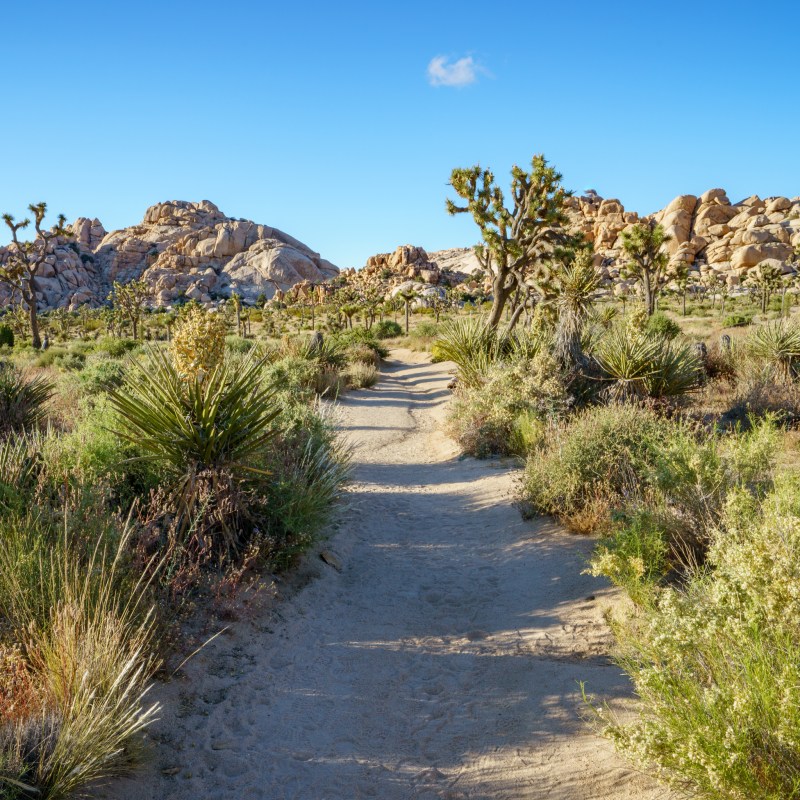
After living in California for 35 years, I finally got around to visiting Joshua Tree National Park for the first time last November, and then I went back in June. I fell in love with the place and know I’ll continue visiting regularly for years to come. The wide-open spaces dotted with spiky Joshua trees and enormous rock formations make this park so scenic. But it’s also full of human history, like Native American petroglyphs, the ruins of mines, and even a deserted ranch. With 1,235 square miles to explore, it’s impossible to become bored.
Videos by TravelAwaits
One of my favorite things to do in any national park is hike. When the popular scenic spots become mobbed with cars and people, I love to get out on the trails and experience nature by myself. Fortunately, Joshua Tree offers dozens of scenic hikes of varying degrees of difficulty.
The trails below are a nice mix of easy and moderate hikes. But all of them offer great scenery, some of which can only be found in this park. If you’re short on time or looking for minimal exertion, go for the first two hikes, which are around a mile each on mostly flat terrain. But if you have a few hours and want a good workout, select one of the final four trails.

1. Barker Dam Trail
A hike along Barker Dam is like a stroll through history. The beginning of this 1.5-mile trail is mostly shaded and winds through giant rock formations. During my recent visit to Joshua Tree, we spent some time rock scrambling in this area — a popular activity in the park. If you’re looking for a great photo opportunity, this is definitely the place. There’s also a wide variety of plant life along this trail.
About halfway along the trail, you’ll see Barker Dam, which was built by C.O. Barker in 1900. In 1949, Bill Keys, an area rancher, raised the dam wall by 6 feet. Just past the dam is an old stone horse trough also built by Keys. The water collected here makes it attractive to birds. If you enjoy bird-watching, Joshua Tree is home to 250 species.
The final stretch of the trail offers no shade, but it does wind its way through hundreds of Joshua trees of various shapes and sizes. Toward the end, be sure to look out for the petroglyphs inside a wind-carved rock.
As a short and easy trail, Barker Dam definitely gets crowded, so I recommend arriving early.

2. Hidden Valley Trail
You’ll also experience a piece of history in Hidden Valley, a place once popular with cattle rustlers hoping to hide their plunder. It’s believed that the entrance to Hidden Valley — and the start of this trail — was created by Keys when he blasted through the rock to make a larger entrance for his cattle.
This flat, mile-long trail takes hikers through a large valley surrounded by giant boulders and rock formations. Along the way, you’ll see several varieties of trees and cacti. The unique microclimate in this valley brings together a combination of plants not seen anywhere else in the park.
The Hidden Valley Trail is great for multigenerational groups and those looking for a quick and easy hike. Be sure to read the signs placed along the route that explain the flora and fauna. Surrounding the parking area are several picnic tables, an ideal spot for lunch before or after a hike.

3. Ryan Mountain Trail
Located in the heart of Joshua Tree is Ryan Mountain, and the trail to its peak will guarantee a good workout and great views. Don’t be misled by the short distance of 1.5 miles each way — the National Park Service rates this trail as strenuous.
Along the way, you’ll see a wide variety of plant life, but what really draws people here is the view of the park. At the top, you’ll have a 360-degree view of Joshua Tree. Regular visitors to the park often call Ryan Mountain the park’s best trail. This is a great sunset hike, but be prepared with a headlamp or flashlight for the descent. Bring a snack to enjoy at the top while you’re admiring the surrounding landscape.
As one of the most popular trails, Ryan Mountain is often busy, so starting early in the day is recommended.

4. Lost Horse Mine Trail
In addition to cattle farming, mining was a popular industry in the area for many years. In fact, in the late 1800s and early 1900s, there were 300 mines here. Most of the mining was unprofitable, but Lost Horse Mine was an exception. It’s believed that 5 million dollars worth of gold and silver was extracted.
The Lost Horse Mine Trail follows the road that J.D. Ryan, one of the former mine owners, built to transport the ore. This moderate trail is 4 miles round trip. Along the way, you’ll appreciate views of the surrounding park, but the main attraction is certainly the old mine. Due to the dangers of crumbling structures and collapsing shafts, everything is blocked by a chain link fence. But it’s still worth the hike to see this piece of history. If you’re up for a bigger challenge, continue along the trail to the ridge where you can look down on the mine.
A definite advantage of this trail is that it’s lesser known and generally not crowded. After your hike, continue up the road to Keys View for one of the best scenic viewpoints in the park.

5. Warren Peak Trail
For another lesser-known trail, head to Warren Peak. In this part of the park, there are few Joshua trees; instead, you’ll see pinyon, juniper, and oak trees. Along the route, you’ll pass Black Rock Spring, which is an important source of water for wildlife. At the end, you’ll not only have views of the park, but also the Santa Rosa Mountains, San Jacinto Mountains, and San Bernardino Mountains.
The Warren Peak Trail is 6 miles long and considered moderate for the most part. However, the last stretch is very steep and described as difficult. Parts of the trail are quite sandy, which will definitely slow your pace. There’s little shade along this trail, so come prepared with water and sunscreen.

6. 49 Palms Oasis Trail
As I started hiking along the 49 Palms Oasis Trail, I wondered where on earth the name had come from. Most of the hike is rocky and steep with little shade. I sometimes found myself climbing over boulders. The trail begins with a long ascent to a ridge, and then a long descent into the oasis. Along the way, you’ll see barrel cacti and an expansive view of the nearby cities, including 29 Palms and Joshua Tree.
After about an hour, I finally understood why this hike is so popular. A cool, palm-tree-packed valley emerged, with giant boulders perfect for lounging. Most hikers spend some time here enjoying the oasis.
This out-and-back trail is 3 miles long.
What To Know Before You Go
Joshua Tree National Park comprises two deserts, the Mojave and the Colorado. As a result, the temperatures can soar in the summer to well over 100 degrees. If you’re visiting in the summer, be sure to get a very early start, wear sunscreen, and bring along plenty of water.
The best time of year to visit the park is spring. The temperatures are mild, and the wildflowers are in bloom. Winter can get very cold and windy, so dress in layers. Fall can also be a lovely time to visit.
Definitely take the time to stop at one of the visitor centers before entering the park. Not only are there great exhibits about the plant and animal life, but rangers are usually available to answer questions and provide suggestions on what to see.
There are no services in the park, so bring everything you’ll need for the day — food, water, sunscreen, and a first-aid kit. Most trails are pretty rocky, and you’ll likely be enticed to do some rock scrambling, so bring your hiking boots. And do observe mileage signs. Speeding in the park has caused the deaths of many wild animals.
No matter which hike you choose in Joshua Tree, you’re going to fall in love with this desert terrain that is full of unique plant and animal life and offers endless opportunities to explore the human and natural history of the region.
The best way to immerse yourself in the park’s scenery is to stay at a vacation rental home. Check out our top picks near Joshua Park National Parks.
For more to see and do in Joshua Tree, see this page. And don’t forget to check out out list of the best Airbnbs in Joshua Tree while planning your stay.
